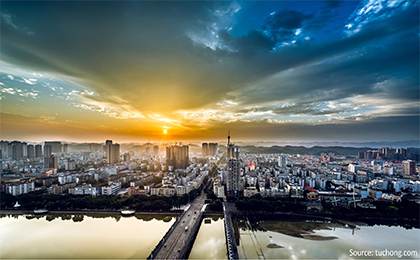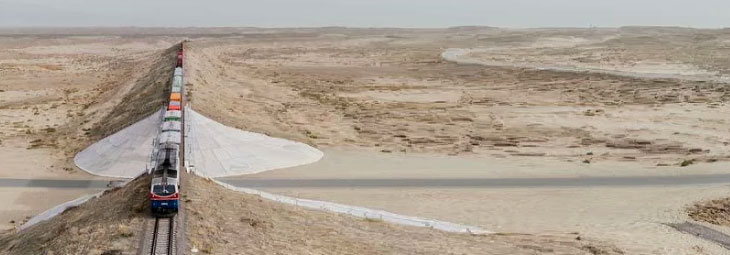


(CNR,23 July 2017)The Belt & Road Initiative has promoted deep communication and cooperation between China and the countries along the Belt & Road area, and fostered more developed and convenient trade over the past four years since it was proposed. There are also some imperceptible changes that are equally significant. For example, we can find that the geo-economics of China have been changing quietly from the perspective of cities. Some small and medium-sized cities in the inland area or even remote locations have gained more development opportunities and become increasingly active.
Deyang is a city with long history and rich culture in Sichuan Province, where the Sanxingdui site was excavated and Zhuge Zhan died in the war of Mianzhu in the Romance of the Three Kingdoms.
Deyang was also famous for its good wine, medicine and craftsmanship in the history. However, there were few opportunities for Deyang to show its beauty to the world due to its remote location in the southwest of China and near the metropolitan area of Chengdu.
Since the proposal of the Belt & Road Initiative, Deyang has become the frontier connecting Central Asia and Europe. The China-Europe Block Trains starting from here reach Europe earlier than the ones from the southeast coastal cities in China. Products of Deyang can be directly transported abroad without additional transshipment, and the foreign goods could come in at any time, which have made its connection with the international market tighter gradually. At the First High Level International Forum on Sustainable Urban Development which just concluded, Deyang has become international obviously as described by Mr. Zhao Hui, Mayor of Deyang. “The New Year Pictures of Mianzhu were selected as the first batch of Chinese intangible cultural heritage projects and sold well in India, Vietnam, Myanmar and other countries. We have successfully held two sessions of Sanxingdui Silk Road Drama Festival, which has won wide acclaim. Besides domestic young actors, actors from France, Romania and other countries also joined in the performance in the drama festival.”
Like Deyang, many other small towns in the middle and west of China have also gotten a ride in the Belt and Road Initiative. For example, Jiayuguan City in Gansu Province, located in the depth of desert, held the China-Russia International Chess Masters Summit Competition and the International Triathlon Challenge, which gathered the popularity and helped the development of local resource-based enterprises through international cooperation.
Mr. Long Yongtu, Chief Negotiator of China’s accession to WTO, believed that the rapid development of small and medium-sized inland cities shows that the Belt & Road Initiative has led to the changes of China’s geo-economics. He said that the interconnection of infrastructure changes the geo-economics positions of many cities, and many inland cities have become the open frontiers.
From an even broader perspective, the small and medium-sized cities in middle and west Asia, especially those with cultural heritage of the ancient Silk Road, are also expected to be more dynamic by taking advantage of the Belt & Road Initiative. At present, more than 60% of the world’s population has gathered along the Belt & Road area, creating nearly one third of the world's economic output. Besides, the Belt & Road area has gathered 2.2 billion urban population, which accounts for about 55% of the world’s urban population. According to the forecast of United Nations, urban population of countries along the Belt & Road area will grow by 1.2 billion by 2050 with the average annual increase of 35 million.
Mr. Peng Sen, Vice Chairman of the Finance and Economic Commission of the National People's Congress, pointed out that the geo-economics changes of China and countries along the Belt & Road area are just built in the volume and potential of the Belt & Road area. He said that, the average urbanization rate of countries along the Belt and Road area in 2015 was 47.5%, 6 percentage points lower than the world’s average. At present, China is still at the stage of rapid urbanization and have common conditions with countries along the Belt and Road area, which brings common goals and internal needs for further cooperation in the field of urbanization.
Transportation usually plays an important role in the change of geo-economics. The next step is to strengthen the interconnection of infrastructure between cities within the framework of Belt & Road Initiative, said Mr. Xu Lin, Director for the Development Planning Division of National Development and Reform Commission. “Focusing on the key channels, cities and projects, we will speed up the construction of roads and railways on the land and ports in the sea, promote the multimodal transport of highways, railways, water and air, and jointly build an infrastructure network connecting Asia, Europe and Africa.”
Source:CNR
<http://www.cnr.cn/jingji/jjgd/20170723/t20170723_523863724.shtml>
Translated by Zhao Shengbo